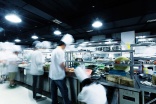Home › magazine › product features › Food hygiene always be prepared
Food hygiene - always be prepared
29th of July 2022What are the key challenges involved with cleaning an area where food is being prepared? Ann Laffeaty asks manufacturers about the logistical, ergonomic and hygiene issues in a commercial kitchen - and quizzes them about their solutions.
CLEANING IN AN ENVIRONMENT where food is being prepared can be a nightmare. Hygiene is particularly important a commercial kitchen because any harmful pathogens are liable to contaminate the foodstuffs. And this could lead to food poisoning, lawsuits and ruined reputations. Strong disinfectants might solve the problem, but these need to be used with care since they are likely to taint the food items.
The fact kitchens tend to be busy, chaotic places presents another challenge. Staff members will be juggling multiple tasks and moving constantly from A to B, leading to logistical problems as far as ongoing cleaning is concerned. And whenever a spill occurs, it will need to be cleaned up immediately before operatives have the chance to slip in it or spread it around.
Restaurant managers are understandably keen to maximise their customer floor space, which means that in many cases the kitchen area will be relatively small and cramped. As a result, large items of cleaning machinery will be impractical.
So in the face of all these challenges, how do industry players prioritise their kitchen cleaning efforts?
Hygiene is always the top priority in any food preparation area, says Filmop’s business development manager Paolo Scapinello. “Dirt and bacteria must be effectively removed from all surfaces that come into direct contact with food,” he said. “So the main goal should be to supply the wherewithal to guarantee high standards of hygiene and that ensure a long-lasting level of cleanliness.”
Speed of cleaning is crucial, particularly during food service times, he adds. “Fast and efficient operations need to be carried out with the aid of non-bulky and easy-to-transport equipment,” he says. “This will quickly restore the hygienic and sanitary conditions essential in a food preparation area.”
According to Scapinello, quick and effective action is necessary for cleaning up any accidental liquid spills - but there are logistical issues involved when staff members are preparing food. “The use of compact and easy-to-handle equipment will be required since this is less likely to interfere with ongoing activities,” he said. ”Any food contamination also needs to be avoided, so sprays should not be used because particles would then be released into the air.”
Manual equipment is ideal for cleaning small food preparation spaces where few electrical sockets are available, he said. “Mopping systems are more appropriate than cleaning machines because they can be used in corners and in hard-to-reach areas,” said Scapinello. “They also facilitate quick clean-ups when emergency cleaning is required.”
Filmop’s new Easy Wash system is designed for use on horizontal and vertical surfaces in small areas such as kitchens. It consists of a touch-free mop holder, microfibre mop, bucket and wringer and is said to avoid any direct contact with the hands or any repeated bending on the part of the operator.
Disorganised environments
Ensuring all surfaces are constantly ready for work should be the top priority in a commercial kitchen according to Essity’s regional marketing manager for horeca Riccardo May. “This is important both from a health risk point of view and also to keep the kitchen running smoothly,” he said.
“Surface cleaning is crucial because any food poisoning organisms, allergens and other potentially harmful substances need to be quickly removed to avoid the risk of contaminating any new items placed on those surfaces. “A ‘clean as you go’ policy should therefore be implemented because this makes each employee responsible for cleaning his or her own area throughout their shift.”
He says time is of the essence during food service hours. “Restaurant kitchens need to be as prepared as possible — even over-prepared — on a daily basis,” he said. “When workflow, hygiene and efficiency are all in sync, staff won’t have to think twice about maintaining high standards of hygiene.”
Cleaning and hand hygiene products need to be placed in strategic positions in all food preparation areas, he adds. “These can make a vital contribution in overcoming the daily challenges posed by a restaurant kitchen,” said May. “Well-placed products will ensure staff members don’t forget to clean their hands while also making the overall cleaning task easier, both during and at the end of service.
“Kitchens that are not optimised will often become cluttered and disorganised environments where health and safety requirements are not met. And these requirements are fundamental to a restaurant’s survival.”
New from Essity is the Tork Performance Washstation dispenser which is designed to give out paper wipers one at a time. The unit is built to withstand wet environments and can remain in place during spray-downs.
Kitchen floors can pose a real problem when it comes to cleaning according to Denis Rawlins managing director James White. “A build-up of grease coupled with frequent spillages can make floors incredibly dangerous,” he said. “And when you add sharp objects and boiling liquids into the equation, the result can be catastrophic for both staff and customers.
“Spills need to be addressed quickly and efficiently to remove the risk of trips and falls and to minimise any disruption to the service. But a thorough daily clean of key areas including the floors should be sufficient to keep grease at bay.”
Most professional kitchens are tiled, and this poses a problem with grease and soils which can build up in grout lines if they are not properly maintained, according to White. “A mop and bucket will simply not cut it,” he adds. “You need a cleaning machine with high-flow fluid extraction technology to clean these hard-to-reach areas and leave the surfaces clean and dry.”
Denis Rawlins’ Kaivac UniVac uses high flow fluid extraction technology to remove grease from kitchen floors. The machine is said to use 65 per cent less water and cleaning fluid than equivalent machines.
The need to clean up during service hours is one of the chief challenges in any food preparation environment, according to GOJO’s managing director UK and Ireland Chris Wakefield. “The kitchen will be at its busiest and staff will be under huge pressure to serve dishes in a timely fashion,” he said. “However, hygiene should never be sacrificed for the sake of speed, which means cleaning needs to be carried out pre, during and post service in order to ensure the food is prepared and served hygienically.”
Clean as you go
Worktops, chopping boards and cooking utensils all need to be kept sanitised at all times, according to Wakefield. “If these items aren’t properly cleaned, bacteria could spread to the food and cause illness,” he said. “And if spills aren’t cleared up immediately there is a risk of slips and falls.”
A shortage of available space can add to the cleaning challenge, he adds. “This leads to logistical issues, particularly when staff members are present,” he said. “But a well-designed kitchen will facilitate the task, particularly when cleaning surfaces such as tiles, stainless steel units, splashbacks and worktops which are all typically smooth and flat. The challenge here is to choose the right sanitising solutions because these need to be safe for food contact use and should not alter the taste or smell of the food.”
He believes surface sanitising sprays and wipes are particularly suitable for use in a commercial kitchen. “These are quick to use and effective, and can be easily incorporated into daily activities alongside thorough hand hygiene and cleaning.”
GOJO’s Purell surface sanitising spray and wipes are designed for use on kitchen utensils, food storage containers, non-porous surfaces and refrigerated display cases. They are bactericidal, fungicidal and virucidal and require no rinsing.
The various types of surfaces in a typical commercial kitchen present a major cleaning challenge according to Kärcher’s senior manager global sales and business development hospitality Gundula Braun.
“These require different cleaning methods, chemicals, textiles and equipment,” she said. “For example, shiny wall tiles should be cleaned at the end of the working day with a high-pressure machine in combination with foam nozzles or cup foam lances and an appropriate detergent.
“As far as food surfaces are concerned, the strictest precautions need to be taken to prevent food items from becoming exposed to any type of chemicals. And floors need to be thoroughly cleaned and dried to prevent them from becoming a slip hazard.”
She says any stubborn residues of dirt, grease and foodstuffs need to be removed swiftly and systematically in accordance with HACCP guidelines. “Otherwise they could become breeding grounds for microorganisms,” she said. “Spotless hygiene is therefore a must in the sensitive food preparation area to ensure the safety of guests and staff.”
Other cleaning challenges include the tight spaces often found in a kitchen; a general lack of power outlets and the need for immediate clean-ups of spills when staff are present, she adds.
“Steam cleaners or steam vacuums should be used and if chemicals are necessary, bottles with foam heads will prevent the formation of aerosols,” she said.
According to Braun, food contact surfaces should only be disinfected after food service is over. “It is important to remove all visible dirt first, then flush surfaces with drinking water after the disinfectant contact time to eliminate any residual disinfectant on surfaces,” she says. “And manual cleaning using textiles is recommended for removing any visible dirt while the kitchen is in operation.”
Small spaces
The problem of tight spaces and a lack of power outlets can be counteracted by the use of compact, battery-operated machines, she adds. “Safety is another key aspect since a cable will quickly become a trip hazard or could drag along dirt across the floor,” she said.
Kärcher offers compact scrubber dryers for use on floors; plus steam cleaners and steam vacuum cleaners for floor and surface cleaning along with a range of manual tools such as textiles, scrapers, squeegees, buckets and trolleys.
According to Braun it is important to maintain an economic balance between effectiveness and cleaning quality. “Spills, broken glass or tableware and fallen food items all need to be removed swiftly to avoid possible dangers for staff and to avoid spreading the dirt further,” she said. “But regular daily floor and surface cleaning should be carried out according to a cleaning programme and hygiene plan.”
She adds the complex nature of kitchen cleaning makes a formal schedule essential. “A cleaning plan will structure the different tasks that need to be performed and ensure the kitchen remains spotless,” she said. “So this needs to be displayed prominently in all areas where cleaning is required and all staff members need to be trained accordingly.”









